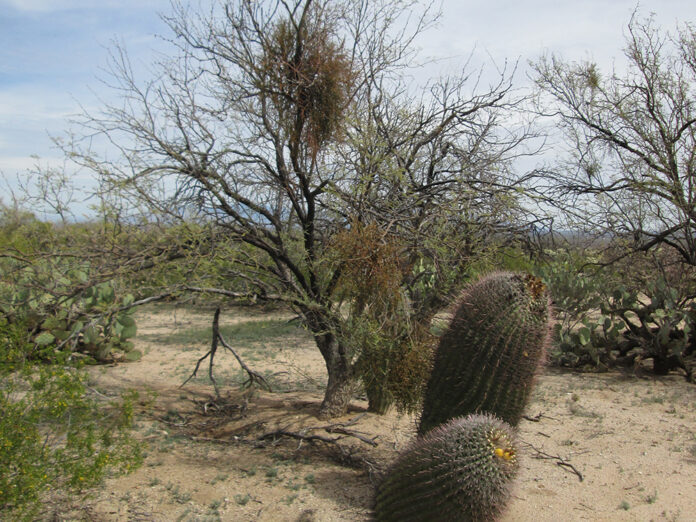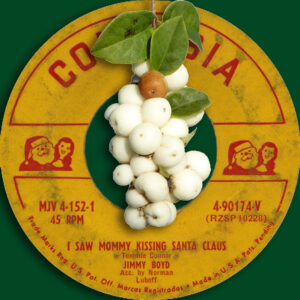
By Beth Sulek-LaHousse
Everyone has heard that if you stand with a loved one under mistletoe you are supposed to kiss that person, but where did the Christmas connection come from? Historians aren’t sure but the tradition has been around for centuries.

Mistletoe’s evergreen foliage and white berries make a pretty Christmas decoration and the tradition of kissing under it just makes for a romantic encounter!
But did you know that mistletoe’s Anglo-Saxon name means dung-on-a-twig? If you squeeze open one of the berries, you’ll find a very sticky seed. The seeds are covered with a glue-like substance called viscin, so they stick to whatever they fall on. When birds eat the berries then excrete the seeds, the seeds don’t fall to the ground, they stick on the branches of trees, hence the dung-on-a-twig reference.
Once the seeds sprout, the tiny roots are sent into the tree bark’s cambium layer, where it siphons off water and nutrients, which slowly weakens the tree and can eventually kill it. This is why mistletoe is considered a parasitic shrub that can be seen on mesquite and ironwood trees in Maricopa.
In Arizona, we have desert mistletoe, or mesquite mistletoe, which differs from the decorative type used at Christmastime. In fact, there are more than 1,300 species of mistletoe, some very useful in nature. Three types of butterflies depend on mistletoe to survive. The great purple hairstreak caterpillars feed on American mistletoe and the Johnson’s hairstreak and thicket hairstreak caterpillars feed on dwarf mistletoe.
Native bees pollinate mistletoe and feed on its nectar. Other insects that feed on and help pollinate mistletoe include flies, ants, beetles, thrips and mites. Many birds eat the mistletoe berries. The Phainopeplas, a silky flycatcher that lives in Arizona, relies almost exclusively on mistletoe for food in the winter.
As a parasitic shrub, mistletoe should be removed from trees. The dense growth of mistletoe can become quite heavy on branches and a large infestation can damage and destroy your beautiful tree. It’s important to remove clusters before they bloom and produce more seeds. Once removed, mistletoe can grow back because its roots grow deep into a tree. The best way to remove it is to hire an experienced tree care professional.
MISTLETOE-TAPPING MUSIC
Nearly 60 years ago, mistletoe sprouted in Christmas music.
 The 1952 hit “I Saw Mommy Kissing Santa Claus,” originally sung by a 13-year-old boy named Jimmy Boyd, is the one of the earliest references to mistletoe in popular music. The holiday staple, of course, has been covered by many popular artists over the years including Andy Williams, The Jackson 5, Reba McEntire and John Mellencamp.
The 1952 hit “I Saw Mommy Kissing Santa Claus,” originally sung by a 13-year-old boy named Jimmy Boyd, is the one of the earliest references to mistletoe in popular music. The holiday staple, of course, has been covered by many popular artists over the years including Andy Williams, The Jackson 5, Reba McEntire and John Mellencamp.
Frank Sinatra wrote and sung about “Mistletoe and Holly” in 1957 and, a year later, the U.S. hit “Rockin’ Around the Christmas Tree” told of couples wishing to stop beneath the white berries.
More recent songs include “All I Want for Christmas Is You” (Mariah Carey, 1994), “Mistletoe” (Justin Bieber, 2011) and “Under the Mistletoe” (Kelly Clarkson, 2020).
This column appears in the December issue of InMaricopa magazine.

![3 things to know about the new city budget Vice Mayor Amber Liermann and Councilmember Eric Goettl review parts of the city's 2024 operational budget with Mayor Nancy Smith on April 24, 2024. [Monica D. Spencer]](https://www.inmaricopa.com/wp-content/uploads/2024/04/spencer-042424-preliminary-budget-meeting-web-218x150.jpg)






![MHS G.O.A.T. a ‘rookie sleeper’ in NFL draft Arizona Wildcats wide receiver Jacob Cowing speaks to the press after a practice Aug. 11, 2023. [Bryan Mordt]](https://www.inmaricopa.com/wp-content/uploads/2024/04/cowing-overlay-3-218x150.png)



![Alleged car thief released without charges Phoenix police stop a stolen vehicle on April 20, 2024. [Facebook]](https://www.inmaricopa.com/wp-content/uploads/2024/04/IMG_5040-218x150.jpg)

![3 things to know about the new city budget Vice Mayor Amber Liermann and Councilmember Eric Goettl review parts of the city's 2024 operational budget with Mayor Nancy Smith on April 24, 2024. [Monica D. Spencer]](https://www.inmaricopa.com/wp-content/uploads/2024/04/spencer-042424-preliminary-budget-meeting-web-100x70.jpg)


